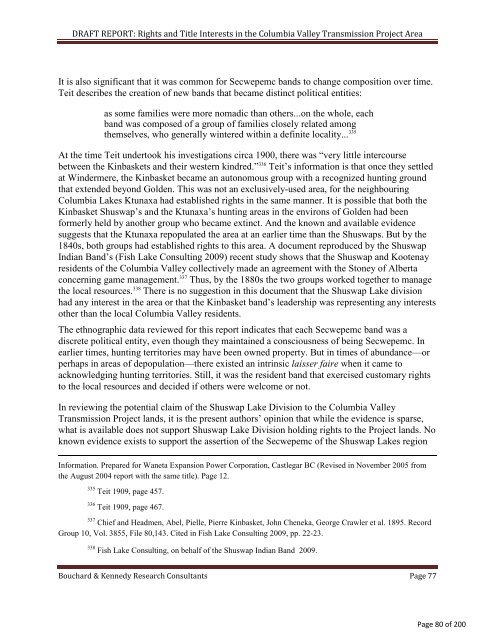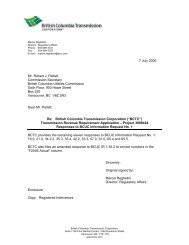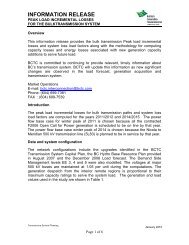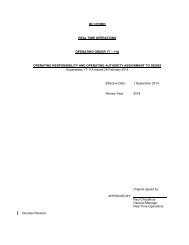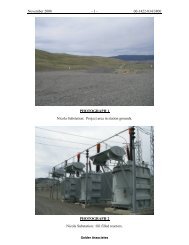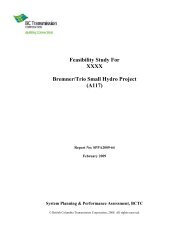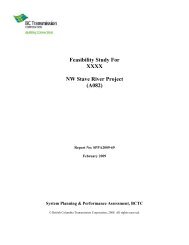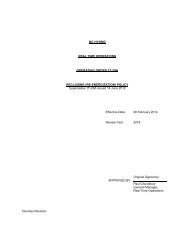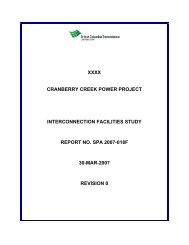Evidence on the Adequacy of First Nations Consultation - BC Hydro ...
Evidence on the Adequacy of First Nations Consultation - BC Hydro ...
Evidence on the Adequacy of First Nations Consultation - BC Hydro ...
You also want an ePaper? Increase the reach of your titles
YUMPU automatically turns print PDFs into web optimized ePapers that Google loves.
DRAFT REPORT: Rights and Title Interests in <strong>the</strong> Columbia Valley Transmissi<strong>on</strong> Project Area<br />
It is also significant that it was comm<strong>on</strong> for Secwepemc bands to change compositi<strong>on</strong> over time.<br />
Teit describes <strong>the</strong> creati<strong>on</strong> <strong>of</strong> new bands that became distinct political entities:<br />
as some families were more nomadic than o<strong>the</strong>rs...<strong>on</strong> <strong>the</strong> whole, each<br />
band was composed <strong>of</strong> a group <strong>of</strong> families closely related am<strong>on</strong>g<br />
<strong>the</strong>mselves, who generally wintered within a definite locality... 335<br />
At <strong>the</strong> time Teit undertook his investigati<strong>on</strong>s circa 1900, <strong>the</strong>re was “very little intercourse<br />
between <strong>the</strong> Kinbaskets and <strong>the</strong>ir western kindred.” 336 Teit’s informati<strong>on</strong> is that <strong>on</strong>ce <strong>the</strong>y settled<br />
at Windermere, <strong>the</strong> Kinbasket became an aut<strong>on</strong>omous group with a recognized hunting ground<br />
that extended bey<strong>on</strong>d Golden. This was not an exclusively-used area, for <strong>the</strong> neighbouring<br />
Columbia Lakes Ktunaxa had established rights in <strong>the</strong> same manner. It is possible that both <strong>the</strong><br />
Kinbasket Shuswap’s and <strong>the</strong> Ktunaxa’s hunting areas in <strong>the</strong> envir<strong>on</strong>s <strong>of</strong> Golden had been<br />
formerly held by ano<strong>the</strong>r group who became extinct. And <strong>the</strong> known and available evidence<br />
suggests that <strong>the</strong> Ktunaxa repopulated <strong>the</strong> area at an earlier time than <strong>the</strong> Shuswaps. But by <strong>the</strong><br />
1840s, both groups had established rights to this area. A document reproduced by <strong>the</strong> Shuswap<br />
Indian Band’s (Fish Lake C<strong>on</strong>sulting 2009) recent study shows that <strong>the</strong> Shuswap and Kootenay<br />
residents <strong>of</strong> <strong>the</strong> Columbia Valley collectively made an agreement with <strong>the</strong> St<strong>on</strong>ey <strong>of</strong> Alberta<br />
c<strong>on</strong>cerning game management. 337 Thus, by <strong>the</strong> 1880s <strong>the</strong> two groups worked toge<strong>the</strong>r to manage<br />
<strong>the</strong> local resources. 338 There is no suggesti<strong>on</strong> in this document that <strong>the</strong> Shuswap Lake divisi<strong>on</strong><br />
had any interest in <strong>the</strong> area or that <strong>the</strong> Kinbasket band’s leadership was representing any interests<br />
o<strong>the</strong>r than <strong>the</strong> local Columbia Valley residents.<br />
The ethnographic data reviewed for this report indicates that each Secwepemc band was a<br />
discrete political entity, even though <strong>the</strong>y maintained a c<strong>on</strong>sciousness <strong>of</strong> being Secwepemc. In<br />
earlier times, hunting territories may have been owned property. But in times <strong>of</strong> abundance—or<br />
perhaps in areas <strong>of</strong> depopulati<strong>on</strong>—<strong>the</strong>re existed an intrinsic laisser faire when it came to<br />
acknowledging hunting territories. Still, it was <strong>the</strong> resident band that exercised customary rights<br />
to <strong>the</strong> local resources and decided if o<strong>the</strong>rs were welcome or not.<br />
In reviewing <strong>the</strong> potential claim <strong>of</strong> <strong>the</strong> Shuswap Lake Divisi<strong>on</strong> to <strong>the</strong> Columbia Valley<br />
Transmissi<strong>on</strong> Project lands, it is <strong>the</strong> present authors’ opini<strong>on</strong> that while <strong>the</strong> evidence is sparse,<br />
what is available does not support Shuswap Lake Divisi<strong>on</strong> holding rights to <strong>the</strong> Project lands. No<br />
known evidence exists to support <strong>the</strong> asserti<strong>on</strong> <strong>of</strong> <strong>the</strong> Secwepemc <strong>of</strong> <strong>the</strong> Shuswap Lakes regi<strong>on</strong><br />
Informati<strong>on</strong>. Prepared for Waneta Expansi<strong>on</strong> Power Corporati<strong>on</strong>, Castlegar <strong>BC</strong> (Revised in November 2005 from<br />
<strong>the</strong> August 2004 report with <strong>the</strong> same title). Page 12.<br />
335 Teit 1909, page 457.<br />
336 Teit 1909, page 467.<br />
337 Chief and Headmen, Abel, Pielle, Pierre Kinbasket, John Cheneka, George Crawler et al. 1895. Record<br />
Group 10, Vol. 3855, File 80,143. Cited in Fish Lake C<strong>on</strong>sulting 2009, pp. 22-23.<br />
338 Fish Lake C<strong>on</strong>sulting, <strong>on</strong> behalf <strong>of</strong> <strong>the</strong> Shuswap Indian Band 2009.<br />
Bouchard & Kennedy Research C<strong>on</strong>sultants Page 77<br />
Page 80 <strong>of</strong> 200


